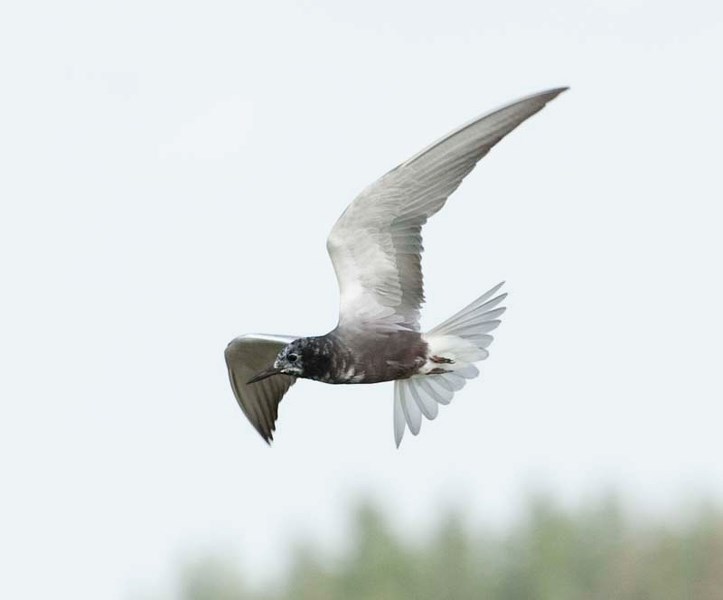Recent visitors to the John E. Poole interpretive wetland might have noticed that the boardwalk is closed. Anyone who ventures past the yellow caution tape and strolls out to the middle of the boardwalk will soon see why, as a squadron of angry, black-feathered fighter jets comes screaming out of the reeds and makes a bombing run on their head.
It's nesting season for the black tern, and that's made the boardwalk an intimidating place to be for some residents. The birds are aggressive defenders and will swoop down at anyone who comes near their nests, coming within about a metre of their heads while unleashing a furious, “SCREEP!”
That's why Alberta Parks officials decided to temporarily close the boardwalk as of Thursday, said parks conservation biologist Matt Wheatley.
“They are being aggressive,” he said of the terns, and there are at least four breeding pairs in the Poole wetland.
Black terns are water birds that are bigger than swallows but smaller than gulls, Wheatley said. They have a black head, neck and belly during mating season (i.e. nowadays) and slate-grey wings and tails. Most of the head, neck and chest become white during wintertime.
You're unlikely to mistake a black tern for anything else, says local naturalist Ludo Bogaert, who has spent many hours photographing them. You could confuse one with a Forster's tern, which is completely white with a black cap, or a Franklin's gull, which is black only around the head.
Black terns can often be seen hovering or swooping over lakes and rivers, Bogaert says, swiftly dipping or pecking at the water's surface to catch bugs and fish. They are also swift enough to pluck dragonflies out of the air. Unlike the Forester's tern, he notes, black terns do not dive completely underwater for food.
Black terns nest in wetlands and shallow water, reports the conservation website ARKive.org, building nests out of mounds of vegetation. You'll usually find many nests in one spot, as the birds nest in colonies, often near areas where dolphins or predatory fish have driven prey to the surface. The birds typically lay two to six eggs, with both parents incubating them for about 23 days.
Many of the black tern nests in the Poole wetland are very close to the boardwalk, Wheatley says – one is a mere five metres away. Get anywhere near them and the terns are sure to take off, circle around and start making runs at your head.
They really squawk as they do so but they never actually hit you, says birder Dan Stoker, who usually responds by ducking.
“Even though they may seem to be scary, I don't think people need to be scared of them,” he says. “They're just trying to put on a good show.”
Due to declining numbers in recent decades, black terns are considered a sensitive species in Alberta, meaning they are being monitored by the province, Wheatley says. Researchers generally blame the decline on habitat (wetland) loss.
Every moment a black tern spends dive-bombing you is a moment that it's not on its nest warming its eggs, leaving its kids exposed to the elements and predators, Wheatley says. Parks officials closed the Poole wetland boardwalk last week in most part to give these terns a better chance at reproducing.
Bogaert criticized this decision, noting that the whole point of the boardwalk was to expose people to birds and their natural behaviours, which, in the tern's case, includes dive-bombing.
“The whole purpose of the boardwalk is for people to enjoy that kind of thing,” he said. “If you want to protect wildlife, don't put a boardwalk through (the wetland).”
Alberta Parks is monitoring the terns in the Poole wetland, Wheatley says, and expects to reopen the boardwalk later this month once the terns are done nesting.
Until that time, bird fans should keep their distance from black terns – or be ready to duck.
Black Tern
Name:<br />Chlidonias niger.<br /><br />Appearance:<br />Small tern with black head and chest, grey wings, blackish-red legs.<br /><br />Commonly seen:<br />Hovering over water at Big Lake, or charging at your head, screaming.<br /><br />Occasionally confused with:<br />Forster's tern, which are white with a black cap, or Franklin's gulls, which are black only around the head.<br /> <br />Fun fact:<br />Known to travel in flocks of up to 10,000 birds.<br /><br />Advisory:<br />Extremely aggressive and territorial during nesting period, which is most of July. Avoid nesting areas during this period.
Wild St. Albert
Like wildlife? So do we! Every second Wednesday the Gazette profiles a reasonably common wild creature in the St. Albert region. Birds, beasts, bugs, fish … so long as it's alive and kicking, we'll feature it. <br /><br />Got a creature you'd like to see profiled? Send your suggestions to [email protected].




